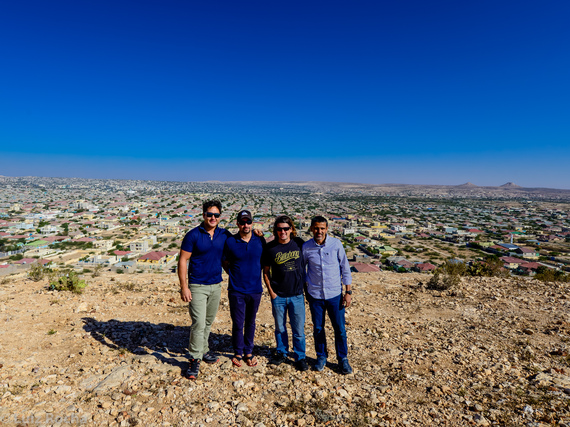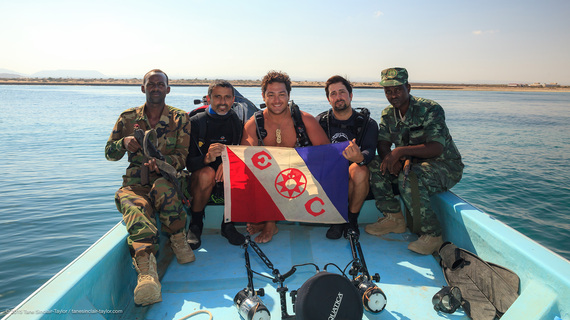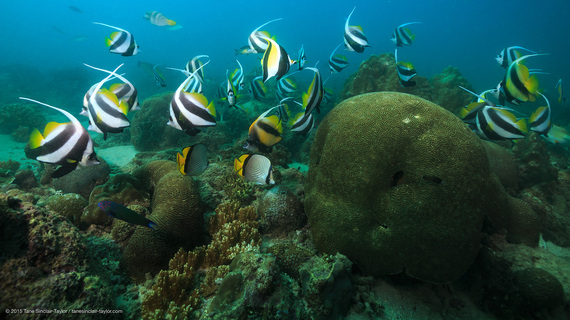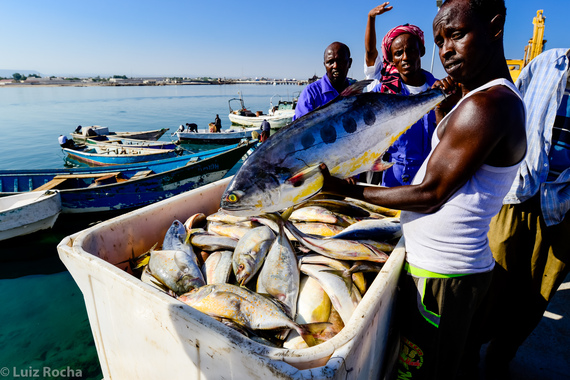My work takes me to some spectacular places, and our latest expedition was no exception: Somaliland. When I told my colleagues where we were going, the reaction was predictably the same, everyone thought we were crazy. The team for this expedition consisted of our fearless leader Dr. Joseph DiBattista (Curtin University, Australia), Dr. Jean-Paul Hobbs (also from Curtin University), field research specialist, nature photographer and Explorer’s Club Fellow Tane Sinclair-Taylor, and myself. The team at a vista point overlooking Hargeisa.
The team at a vista point overlooking Hargeisa.
Even though not recognized internationally, Somaliland (northern Somalia) feels like it’s own country. They have their own currency, and try to distance themselves from their southern neighbors as much as possible. Getting there presented some challenges. Everyone needed visas, and the only flights to Hargeisa were out of Dubai. After endless hours in airplanes and airports, we finally arrive and are greeted by our tour guide, Khalid Osman.
After a quick breakfast we set out for the coast, and our first stops were at the livestock market and Laas Geel, a very interesting site with cave paintings dating back 5,000 years. Joseph DiBattista at Laas Geel.
Joseph DiBattista at Laas Geel.
But the main objective of our trip was to conduct a survey of the coral reefs of Somaliland, off the port city of Berbera. Very few researchers have been there, and the data we collect will be very important for understanding the ecology, evolution, and ultimately to help conserve these unknown reefs. Our primary tasks are to document as many species as possible through photography, collect a few specimens to deposit in museums and make them available to studies worldwide, and conduct visual surveys of the fish fauna. The diving routine is not much different from elsewhere, with one glaring exception: we have to be escorted by armed Somaliland guards. The guards are there for protection from possible pirates since we are dangerously close to the neighboring Somalia. Our team holds the Explorer’s Club Flag beside Somaliland guards.
Our team holds the Explorer’s Club Flag beside Somaliland guards.
The diving is very shallow and the waters are turbid, but there are a lot of surprises. Many species that we only saw in deeper reefs on other sites seem to be present in much shallower areas here. We think this is because in the absence of deeper reefs, these species are forced to live in shallower areas. Since Somaliland lies at the marine border between the Red Sea and the western Indian Ocean, we notice a lot of of mixing between species of these areas. Abundance and beauty at the coral reefs of Somaliland.
Abundance and beauty at the coral reefs of Somaliland.
Something else surprises us. Overall, the reefs are very healthy, fishes seem to be thriving and there are a lot of big fish, observations unfortunately not often seen outside marine protected areas (MPAs) these days. A combination of three factors may be contributing to this curious observation: 1) culturally, Somaliland people don’t consume fish with their main protein sources being goat and camel; 2) the small fishing fleet is primitive and does not target reefs; 3) the area is so close to Somalia that illegal fishing fleets don’t operate here. I only saw this many big fish outside MPAs in two other areas, Djibouti and Socotra, and they share these same three characteristics with Somaliland. Pelagic fish arrive at the port of Berbera.
Pelagic fish arrive at the port of Berbera.
There are a few NGOs operating in the area, trying to help fishermen bring more fish into Somaliland’s diet. This is a commendable effort, however, we suggest that it should only be done if it comes hand to hand with good fisheries management. We have seen many countries overfish their stocks exactly because fishing subsidies don’t often come together with good fisheries policy and we sincerely hope this is not repeated here. But overall our impression was very positive: pristine-like reefs and healthy fish populations in an unlikely corner of the world.
________________________________
For much more about Somaliland, read Dr. Joey DiBattista’s four-chapter blog.




























